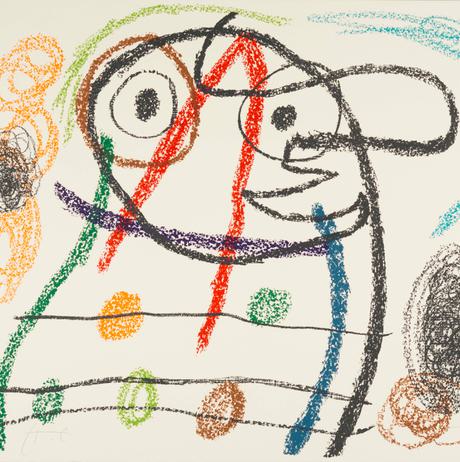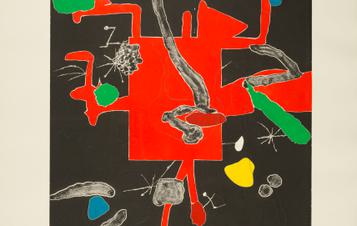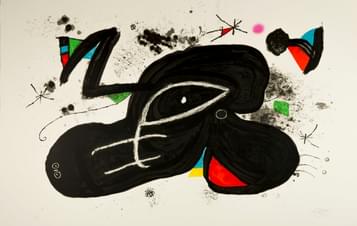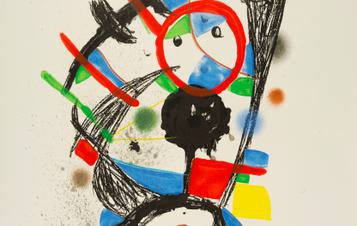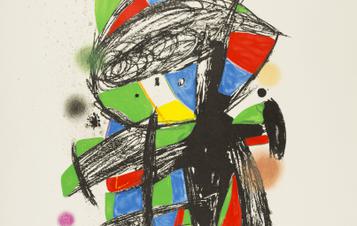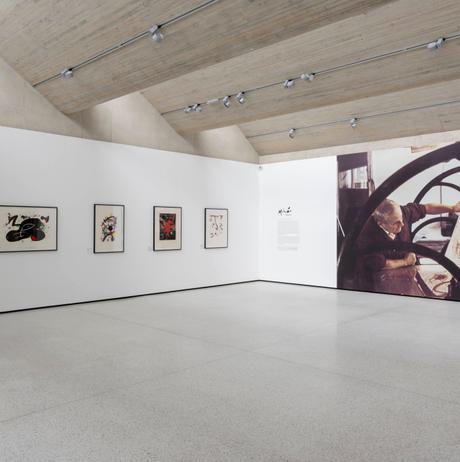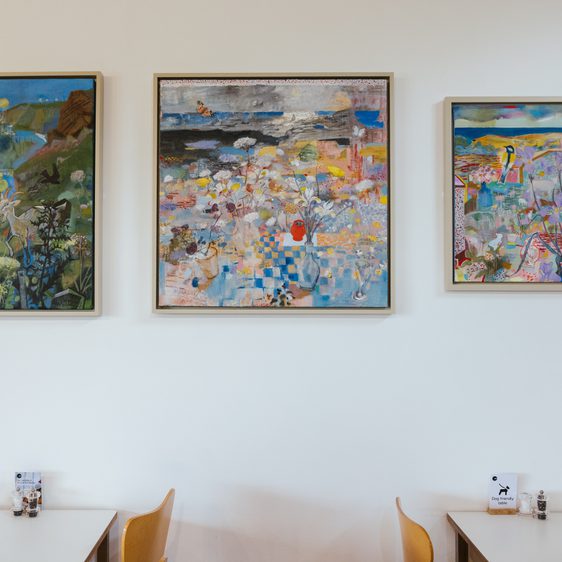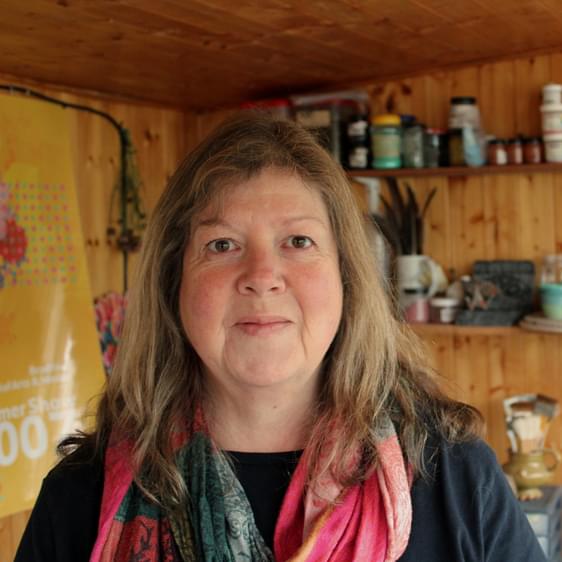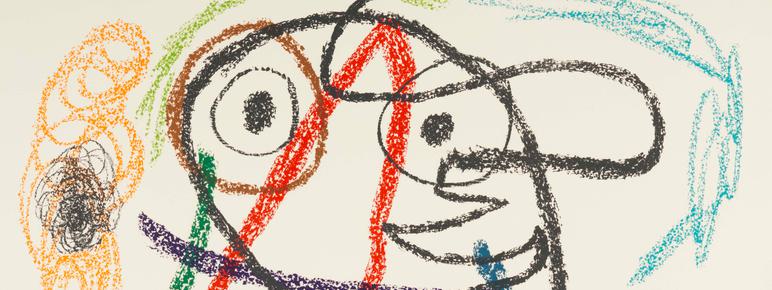
About Miró
YSP is delighted to present an exhibition of rare lithographs and etchings by Joan Miró, one of the most celebrated artists of the twentieth century. Often viewed primarily as a painter, Miró was also an incredible sculptor and a prolific and dynamic printmaker, as well as producing ceramics, murals and tapestries.
Yorkshire Sculpture Park embodies perfectly Miró’s hopes for art – that it be displayed beautifully in galleries and landscapes where it can be enjoyed by the many
- Joan Punyet Miró, grandson of Joan Miró
During an interview in 1951, Miró was asked about how the public could get close contact with art in their everyday lives, given the barriers of cost and access, and he said, “one should never give up. I suggest the solution of colour prints”. Miró saw printmaking as a democratic medium that enabled his works to be circulated to and owned by a wide audience in a meaningful way that did not simply rely on photographic reproductions.
Across all the media in which he worked, Miró had a passionate, singular vision and an unmistakably rich visual vocabulary, bringing together signs and symbols, a bold colour palette, assured strokes, strong line, and a cast of enigmatic characters, or monsters as he sometimes called them.
Miró embraced and experimented with many different printmaking techniques. In the spirit of collaboration, within which he thrived, he worked with experts and learned from them, but always ultimately followed his own path to achieve the results he desired. Through his connection with eminent printmaker Robert Dutrou, in 1967 Miró was introduced to carborundum, a very painterly and textural print medium, which transformed the artist’s later graphic work and through which he said he created “images to rival any painting”. This technique allowed Miró to “express myself without a single hindrance, at a single burst of spirit, without being paralyzed nor slowed down by an outmoded technique that might risk distorting the free expression, purity and freshness of the final result”.
Miró worked with some of the most respected print studios in France and Spain, including Fernand Mourlot, and Aimé Maeght in Paris, and JJ Torralba in Barcelona, who produced many of the prints in this exhibition. His exceptional work as a printmaker was acknowledged in 1970 with the exhibition Fifty Recent Prints at the Museum of Modern Art in New York. Recognised as one of the last century’s most significant and revered artists, Miró’s work is held in major public and private collections all the world.
Works in the exhibition
Son Abrines
The Son Abrines series comprises three prints and is named after the place where Miró built his Mallorcan studio. In the early 1950s, the artist bought some land on a hillside outside Palma, with magnificent views across the Mediterranean. He commissioned his friend, the Catalan architect José Lluís Sert, who he had known since the 1930s, to design the studio that he had always dreamed of. By 1956, the studio was complete and Miró said “In the new studio I had enough space for the first time”. The striking exterior of this modern building combines white concrete and terracotta, incorporating splashes of Miró’s characteristic colours of red, blue and yellow.
The two prints shown here, Son Abrines I and II, are closely related to one another in terms of composition but look very different on first sight. Son Abrines I has a dense black background with a vibrant red rectangle at its centre, from which a number of lines and shapes emanate. Son Abrines II does not feature these bold black and red elements but otherwise its forms are identical. When placed against the negative space of the paper these marks become far more prominent and isolated, giving the print a radically altered sense.
Soon after Miró moved into Taller Sert (the Sert Studo), he wrote, “The new studio, which seemed so big, is already full. Fortunately, a large house near mine recently came up for sale… I bought it right away. It’s filling up very fast.” This house was Son Boter, the traditional eighteenth-century rural Mallorcan house that became Miró’s print studio from 1959, and is introduced by the artist’s grandson, Joan Punyet Miró, in the accompanying film.
Album 21 (Poème de Carlos Franqui)
Miró met Cuban poet and writer Carlos Franqui in the 1970s. As well as writing poetry, Franqui was a journalist, political commentator, activist and art critic, who had been involved with the Cuban Revolution in the 1950s when he was an associate of Fidel Castro and became editor of Communist newspaper Revolucíon. In 1968, after growing differences with the regime, he moved to Europe where he lived in exile. At this time, he met and worked with not only Miró but also his fellow artists and friends including Picasso and Calder.
Miró worked with Franqui on several projects, including in 1976 when he contributed to a portfolio of prints by a number of artists that accompanied poems by Franqui called Poemas para mirar, described as a “call for solidarity with oppressed people”. For Album 21, Miró created a series of 21 lithographs to illustrate the poet’s words, five of which are shown here.
Colombine à La Fenêtre 1980
Arlequin Enturbanné 1980
Malabarista 1980
The Harlequinade is a comic performance piece for theatre with a cast of characters including Pierrot and Clown, as well as Harlequin and Columbine, who feature in these prints along with a number of others by the artist. The two are in love but Columbine’s father Pantaloon tries to keep them apart in the hope of finding a preferable match for his daughter. As far back as 1924/5, Miró painted the iconic Carnival of Harlequin, which has been interpreted as an enactment of the subconscious mind, and demonstrates his long-lasting interest in this zestful subject that abounds with colourful costumes, masks and exaggerated characters.
Malabarista represents a juggler and the coloured strokes and circular shapes suggest movement of the juggling balls and energy of the performer. A love of the vibrancy and frivolity of the circus was something that Miró’s very good friend, the artist Alexander Calder, also famously shared. Calder created a well-known miniature circus – a circus ring with a cast of mechanical animals and performers made from wire and found materials that he activated. His first ever showing of the circus was to a small but distinguished audience including Miró as well as artist Fernand Léger and poet Jean Cocteau.
XV Premi Internacional de Dibuix Joan Miró 1976
In 1962 the first Joan Miró Drawing Prize took place. Miró designed the catalogue covers and this print is the cover from the fifteenth prize in 1976.
Paysanne Endormie 1981
Paysanne Endormie or Sleeping Peasant Woman is one of a number of prints from 1981 featuring this character, including Peasant Woman with Birds, Listening to the Sea, and Angry Peasant Woman. In each the character is represented as a curvilinear, solid black shape that dominates the picture space. Small elements of colour are also introduced, along with subtle line and expressive markings along with symbols such as Miró’s characteristic stars.
With grateful thanks to Successió Miró.
The provenance of all these works is the collection of Joan Miró’s family.
